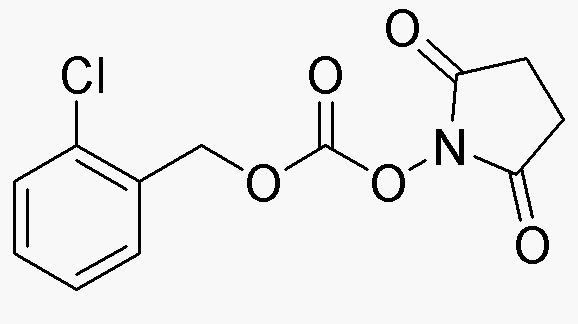N-2-Chlorobenzyloxycarbonyloxysuccinimide is widely utilized in research focused on:
- Peptide Synthesis: This compound serves as a valuable reagent in the synthesis of peptides, facilitating the formation of peptide bonds with high efficiency, which is crucial for drug development and protein research.
- Bioconjugation: It is employed in bioconjugation processes, allowing researchers to attach biomolecules to surfaces or other molecules, enhancing the functionality of diagnostic tools and therapeutic agents.
- Drug Delivery Systems: The compound is used in the development of advanced drug delivery systems, improving the targeting and release profiles of pharmaceuticals, which can lead to better patient outcomes.
- Research in Cancer Therapy: Its application in cancer research helps in the design of targeted therapies, where it can be used to modify drugs for improved efficacy against specific cancer types.
- Analytical Chemistry: This chemical is utilized in analytical methods for the detection and quantification of various compounds, aiding in quality control and regulatory compliance in pharmaceutical manufacturing.
General Information
Properties
Safety and Regulations
Applications
N-2-Chlorobenzyloxycarbonyloxysuccinimide is widely utilized in research focused on:
- Peptide Synthesis: This compound serves as a valuable reagent in the synthesis of peptides, facilitating the formation of peptide bonds with high efficiency, which is crucial for drug development and protein research.
- Bioconjugation: It is employed in bioconjugation processes, allowing researchers to attach biomolecules to surfaces or other molecules, enhancing the functionality of diagnostic tools and therapeutic agents.
- Drug Delivery Systems: The compound is used in the development of advanced drug delivery systems, improving the targeting and release profiles of pharmaceuticals, which can lead to better patient outcomes.
- Research in Cancer Therapy: Its application in cancer research helps in the design of targeted therapies, where it can be used to modify drugs for improved efficacy against specific cancer types.
- Analytical Chemistry: This chemical is utilized in analytical methods for the detection and quantification of various compounds, aiding in quality control and regulatory compliance in pharmaceutical manufacturing.
Documents
Safety Data Sheets (SDS)
The SDS provides comprehensive safety information on handling, storage, and disposal of the product.
Product Specification (PS)
The PS provides a comprehensive breakdown of the product’s properties, including chemical composition, physical state, purity, and storage requirements. It also details acceptable quality ranges and the product's intended applications.
Certificates of Analysis (COA)
Search for Certificates of Analysis (COA) by entering the products Lot Number. Lot and Batch Numbers can be found on a product’s label following the words ‘Lot’ or ‘Batch’.
*Catalog Number
*Lot Number
Certificates Of Origin (COO)
This COO confirms the country where the product was manufactured, and also details the materials and components used in it and whether it is derived from natural, synthetic, or other specific sources. This certificate may be required for customs, trade, and regulatory compliance.
*Catalog Number
*Lot Number
Safety Data Sheets (SDS)
The SDS provides comprehensive safety information on handling, storage, and disposal of the product.
DownloadProduct Specification (PS)
The PS provides a comprehensive breakdown of the product’s properties, including chemical composition, physical state, purity, and storage requirements. It also details acceptable quality ranges and the product's intended applications.
DownloadCertificates of Analysis (COA)
Search for Certificates of Analysis (COA) by entering the products Lot Number. Lot and Batch Numbers can be found on a product’s label following the words ‘Lot’ or ‘Batch’.
*Catalog Number
*Lot Number
Certificates Of Origin (COO)
This COO confirms the country where the product was manufactured, and also details the materials and components used in it and whether it is derived from natural, synthetic, or other specific sources. This certificate may be required for customs, trade, and regulatory compliance.


